Menus
- What you must remember
- Themore
- Theless
- Prices
- Make yourKawasaki NINJA H2 2016
- Opinion
- Performances
- The technical aspect
- Competitors
- Gallery
- Related articles
After having caused THE shock in the world of sports with its Ninja H2R, its compressor and its 326 horsepower (in dynamics), Kawasaki pulls out the speedbrakes a little to validate its madness in common bikers. The H2R promises to be an exceptional motorcycle; why not offer a big part of this exclusivity to a less elitist, almost accessible clientele ?!? This is the role of the H2, without the R, more than 100 horses less, with the vast majority of the H2R technique, and for a less toxic price..
So yes, you have to start with the thing that annoys a little. In its “road” version, the H2 has lost a lot of cannons. 39% less watts, it spoils the picture a bit when the audience was gargling with demonic and surreal power. A piece of the dream is torn apart, the scent of the fantasy fades away. Then reason takes over. Hey, guys, 200 nags is still quite a bit of cavalry, that only 0.1% of bikers would be able to exploit. What happened to make the 998cc block descend into the “standard” missile frontier? ?!?
Kawasaki is not very verbose on technical changes. But seeing the speeds where the maximum powers are obtained, one could assume that the on-board electronics limit rotary flights: the H2 slams 200 hp at 11,000 rpm / the H2R reaches 310 hp at 14,000 rpm. Would the 4 cylinder of the H2 only be electronically restricted? Surely not. It is indeed the same block on both machines, but the camshafts, head gasket, clutch and other engine parts are different. Also, the H2 has only one of the two air lines to breathe..
Less revs, less watts, but the same technology on this H2. Kawasaki has designed a modern 4-cylinder engine, without extravagance except this famous compressor. The air begins by rushing into the gills of the fork crown, arrives in front of a turbine where it is strongly compressed in the air box, up to 2.4 bars (H2R). And this turbine, it mills like crazy. Driven by a gear set connected to the crankshaft, its rotational speed reaches 130,000 rpm at full load and the air flow blows up to 200 liters per second (H2R).
By choosing a compressor rather than a turbo, Kawasaki saves space. The circulating air heats up much less, so no need for an intercooler. Nor of a whole bazaar of conduits to redirect the exhaust gases. And by design, the specific compressor for this machine allows for a much earlier and much stronger engine response..
I can see that remains on their bitterness that such a machine leaves the same potato as a ZX-10R, equipped with a non-supercharged boiler. Be curious, consider that boilers react differently. On the H2, the compression ratio is only 8.5: 1; hypersport compresses to 13: 1. And when it comes to torque, for the same engine capacity, the H2 comes out 2 mkg more (and even 5 for the R).
Above this engine, the air box deserves your attention in more ways than one. With the pressure balanced by the compressor, it was out of the question to fit a plastic casing as seen under all the tanks. On the H2 and H2R, it is a piece of high rigidity aluminum. Inside you will only find the intake vents and a battery of injectors (the other is placed in front of the intake duct). The air filter has moved and is placed before the compressor.
These technical choices, the pilot will perceive the potential with surprise and great sensations. Because if the H2 calibrates you 200 horsepower like its cousin ZX-10R, it is in terms of engine response that the first will drop the other. With its turbine, it is a much denser mixture that flows into the cylinders. Kawa announces an exceptional breath, as if a hypersport had eaten the couple and the availability of a 1400 ZZR. Let’s simplify: by opening wide, a ZX-10R accelerates while an H2 takes off.
Beyond the supercharging and the “full” side of the engine, the Kawasaki H2 offers its own dimension of sport and extravagance. The H2 is aggressive in all points, only differentiating itself from the H2R by the installation of the essential homologation elements..
Beautiful or mean, disturbing or exacerbated, furious certainly, everyone will be attracted by this science fiction plastic. A brute !
Since the H2R, the obligations to drive it on the open road have somewhat scratched its specificities. The ailerons have disappeared, replaced by mirrors incorporating the turn signals. He had to install a license plate holder, that even he wondered what the hell he was doing here. And the headlights, where do they fit? Like a cyclops, right in the middle of the face. Full LEDs, a lenticular optic, extended by two luminous canines, charge lumens and photons. As for the single-sided arm, a refinement unanimously appreciated on pedigree machines and novelty for Kawa, it accommodates the same and superb star-shaped rim of the H2R…. shamefully semi-hidden by a huge exhaust. You have to transfer it immediately; good, apparently there is a better integrated Akrapovic in the options catalog. But without this “egronorme” pot, not sure that the public authorities appreciate the big decibels – the H2R with its racing exhaust sends 120 dB, the level of a jackhammer !
What also surprised everyone, and confirms that the H2 and H2R are exceptional Kawa, is the use of a tubular steel trellis-type frame. All Japanese sports cars have been using an aluminum perimeter for a long time. However, it was necessary to promote air circulation within the machine. Its geometry is a little different from that of the R. Not many things but at this level, it can be felt. A longer wheelbase of 5 mm, from 1450 to 1455 (relatively large for a sports car), a more closed column angle, of 24.5 ° instead of 25.1 °, and a trail reduced from 108 to 103 mm. Side rigidity, no problem to have: the structure present is designed to handle almost 330 horsepower. So with 200, it’s not tomorrow that you’re going to twist a tube. And then, it does its little effect, especially painted in Kawa green. The Akashi brand has also developed a very technical paint especially for the H2. A unique silver mirror color with delicate features. In the shade, the painted parts appear black-gray; once in full light, the surface becomes reflective and reflects the surroundings. Surprising !
A little Ohlins on board? Yes, the steering damper is from the renowned OEM. This is adjusted automatically, via the calculations of the on-board electronics. For the fork and the shock absorber, Kayaba is in demand. The H2 took the opportunity to inaugurate the AOS II racing model on a road motorcycle, based on models with a separate air / oil cartridge of cross-country motorcycles. This 43mm inverted element adjusts for compression, preload and rebound from the top of the tubes. The rear shock absorber is attached to the Unitrack system and benefits from the same settings.
For the brakes, we go to Italy. Only Brembo could decently fit on a motorcycle of this caliber. And the gear is serious: large 330 mm discs with M50 monobloc radial calipers, aviation hoses, a Brembo master cylinder, and complete with a 250 mm disc at the rear with double piston caliper.
Cut like a stealth fighter plane, the H2 contains almost as much electronics. Let us list the panoply supplied in series:
– KTRC traction control, with 3 modes (Circuit, Road, Rain)
– KLMC stationary start aid, configurable in 3 modes, preventing skidding and limiting wheeling
– KEBC engine brake management, also 3 modes
– KIBS intelligent sport ABS, of the same type as that of the ZX-10R but re-configured. Its role is not limited to preventing the wheels from locking, but also to regulate and optimize braking between the front and the rear..
– Shifter KQS, for lightning-fast gear changes. Another new assistance on a Kawasaki
– Electronic steering damper
Hey, the dashboard is not giving in to the full digital TFT LCD tablet fashion…. A no-frills digital screen, a big, big needle-operated tachometer where the numbers start with a moment of suspense, and a circle of symbols enclosing it all. Sober, complete, elegant; although we expected a spaceship cockpit, given the vocation of the craft.
With its 1000 Ninja H2, Kawasaki wants you to taste a new experience, with sensations of acceleration unknown on another sportswoman of this proportion. And by the same to make your own a little of the dream of the H2R. The machine is not a featherweight with its 238 kilos, that is to say that of an R 1200 GS, but its vocation is not the competition. She wants to offer fantasy to her only driver (the H2 only exists as a single-seater), an incredible push everywhere, hard drugs on the open road. Moreover, to afford his shots, we had to wait for legalization … sorry, the end of the law of 100 horses. The “civilian” Ninja H2s therefore did not arrive until 2016. Kawasaki painstakingly manufactures them in a space reserved for them in the Akashi factory, where each one is assembled by hand by one and the same person. For the most demanding and for twice the price, the H2R will allow you to confuse the circuit with the stratosphere.
What you must remember
Themore
Theless
Prices
26,000 €
Price
nine
Compare
the credits
Make
yourKawasaki NINJA H2 2016
Estimate, calculate and compare the cost of insuring your motorcycle.
Calculate the cost of
insurance
Test the price of the motorcycle insurance specialist
Opinion
on 19 opinion
users
Read the reviews
Model marketed in
2016
2017
2018
2019
2020
Performances
-
Max speed:
about 300 km / h
The technical aspect
Kawasaki NINJA H2 2016
- Frame
- Frame: tubular steel trellis
- Tank: 17 liters
- Seat height: 825 mm
- Length: 2,085 mm
- Width: 770 mm
- Height: 1125 mm
- Wheelbase: 1,455 mm
- Operating weight: 238 kg
- Train before
- Telehydraulic inverted fork Ø 43 mm, deb: 120 mm
- 2 discs Ø 330 mm, Brembo 4 piston radial calipers
- Front wheel:
120/70
– 17
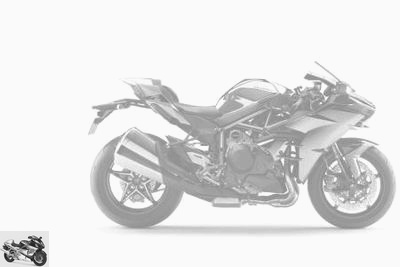
- Transmission
- 6-speed gearbox
- secondary by chain
- Rear axle
- Mono-shock absorber, deb: 135 mm
- 1 disc Ø 250 mm, 2 piston caliper
- Rear wheel:
200/55
– 17
- Motor
- 4 Cylinders
in line
, 4 stroke - Cooling: by water
- Injection Ø 50 mm + compressor
- 2 ACT
- 4 valves per cylinder
-
998 cc
(76 x 55 mm) -
200
ch
at 11,000 rpm - 210 hp with forced air
-
13.60 mkg
at 10,500 rpm - Compression: 8.5: 1
- Crit’air:
Detached pieces
exhaust
motor
fluid
electricity
filtration
braking
chain kit
Competitors
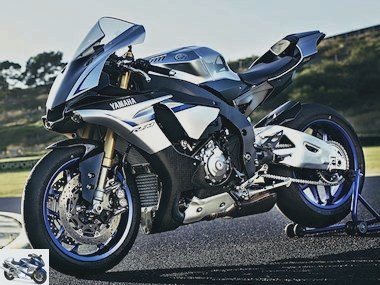
Yamaha YZF-R1M 1000 2016
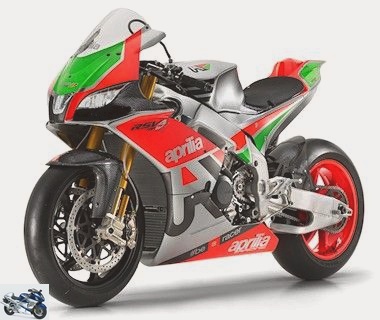
Aprilia 1000 RSV4 R-FW Stock1 MM Race 2016
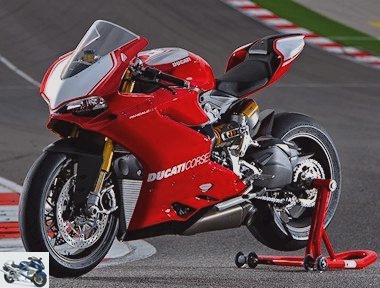
Ducati Panigale R 2016
Gallery
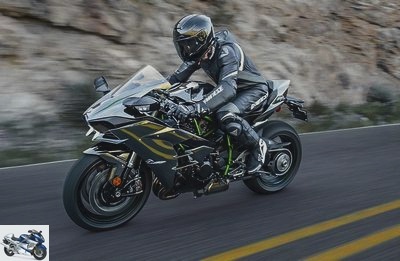
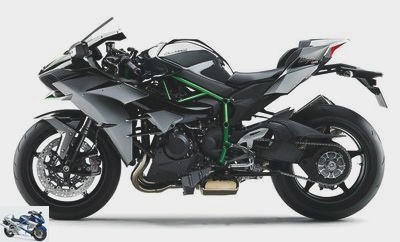
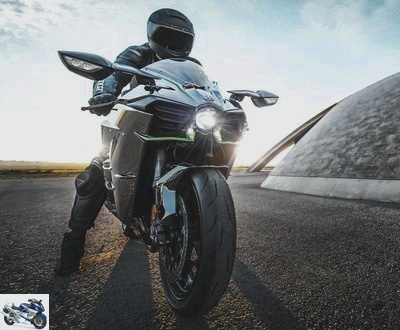

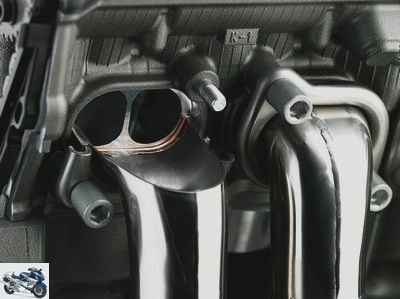
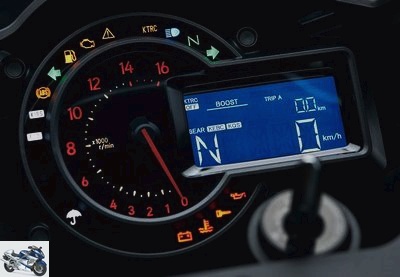
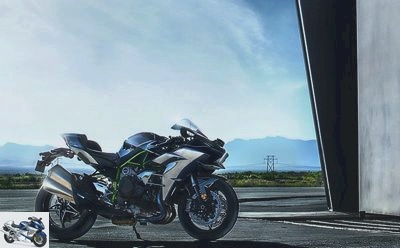
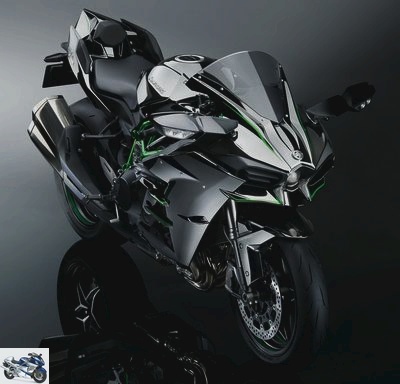
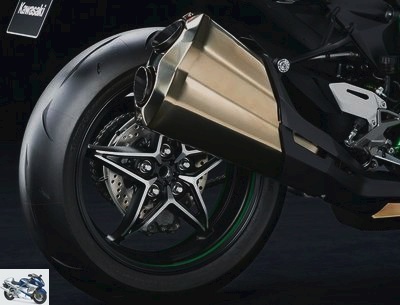
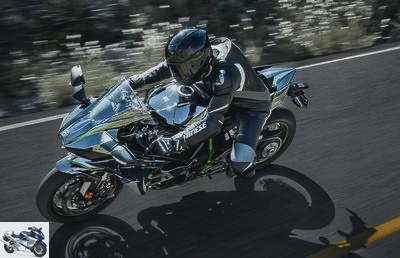
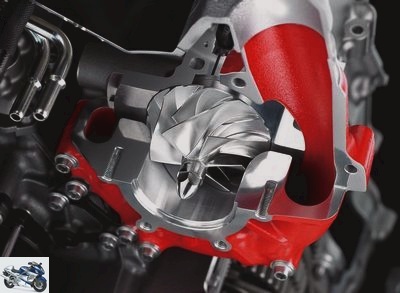
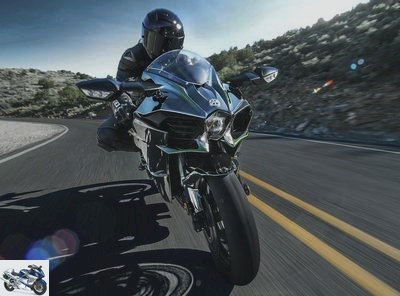
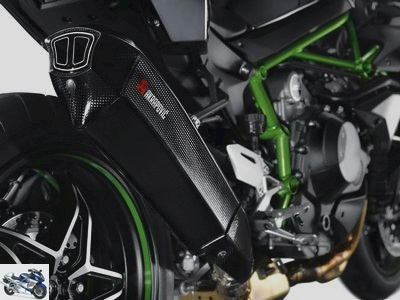
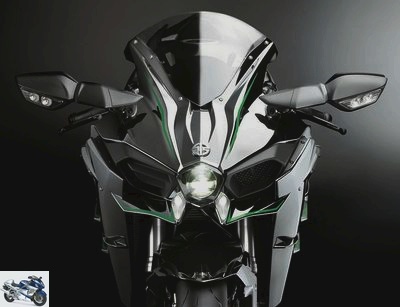
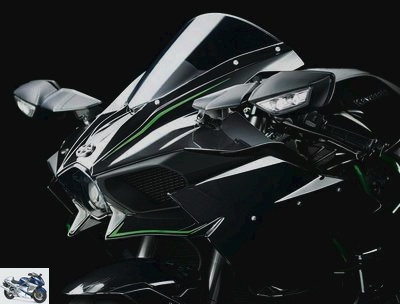
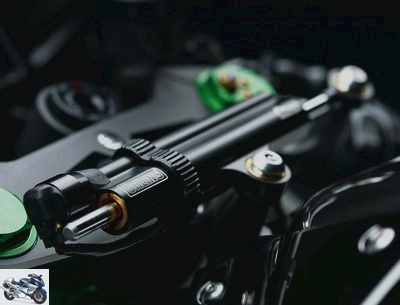
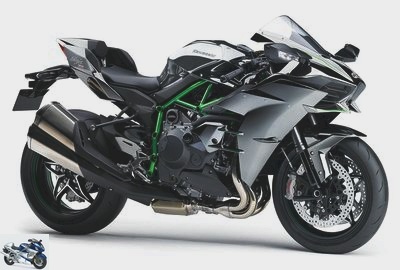
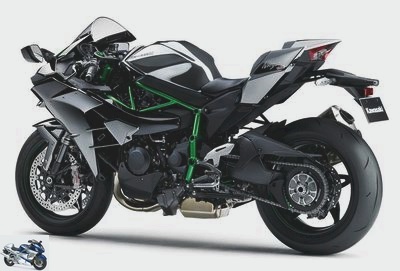
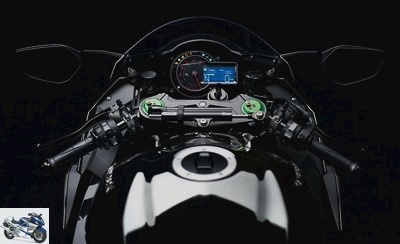
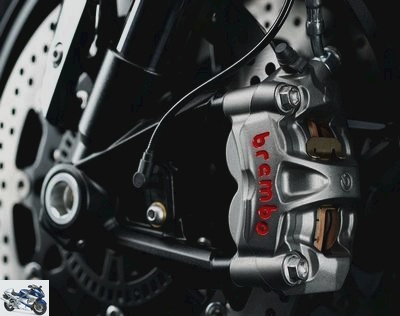
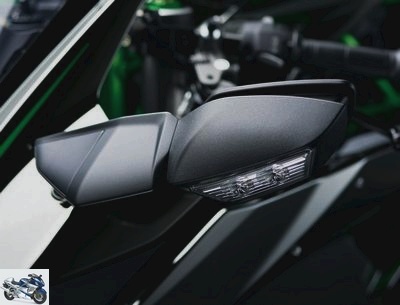
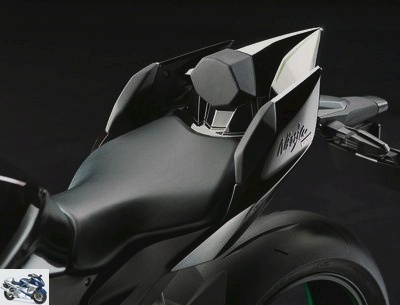

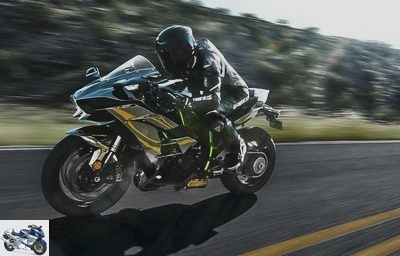
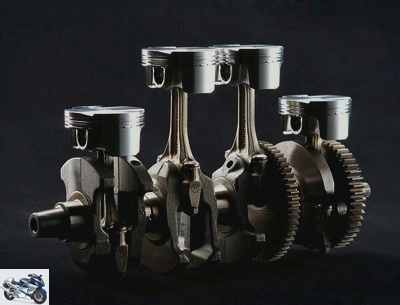

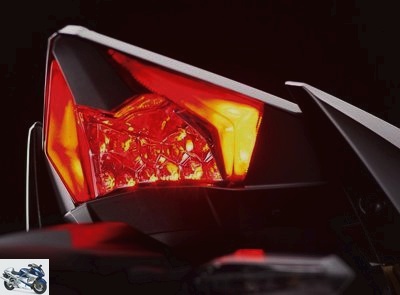
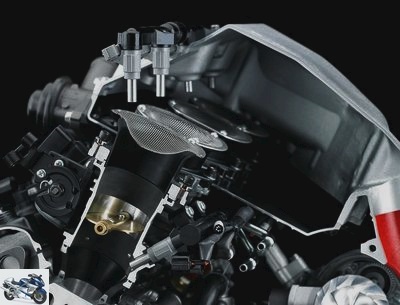
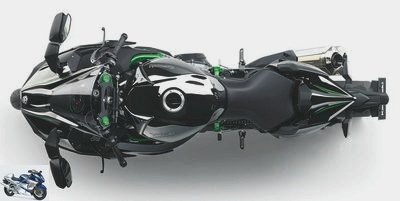
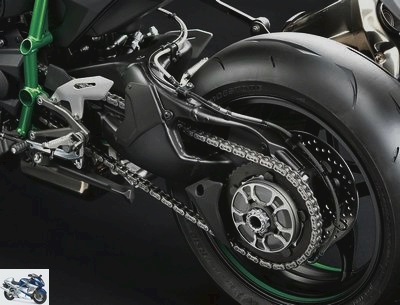
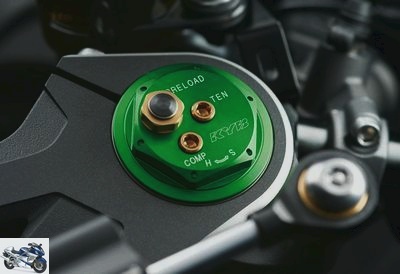
Related articles
-
Some motorcycles had familiarized even reached the stage of madness. The Kawasaki Ninja H2R goes beyond all of that. With this totally surreal…
-
After having caused THE shock in the world of sports with its Ninja H2R, its compressor and its 326 horsepower (in dynamics), Kawasaki pulls out the…
-
The most demonic sportswoman in motorcycle production, the Kawasaki H2R became an icon from its presentation before attracting the most extreme…
-
After having caused THE shock in the world of sports with its Ninja H2R, its compressor and its 326 horsepower (in dynamics), Kawasaki pulls out the…
-
On the vast majority of motorcycles, when you turn the right grip you are fully aware of what is going to happen and you dose accordingly. On the other…
-
All superlatives have been used to define H2R. Some minor changes will thus have difficulty finding an echo in the aura of this exceptional bike. Yet…
-
Going from 750 to 800, the Z has become more powerful, fuller, better suspended, more efficient … In short, more and better everywhere; except at the…
-
She had disappeared … to come back better, more conquering and dapper than ever. Who ? But let’s see the W 650! Sorry, the W 800 !!! The one that…
-
All superlatives have been used to define H2R. Some minor changes will thus have difficulty finding an echo in the aura of this exceptional motorcycle….
-
After the H2, here is the SX. Kawasaki had warned that its supercharging technology would not be limited to a sultry sports car. The second chapter takes…